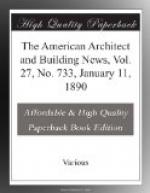June, 1888, in Terri, Italy, a tinner was killed on the roof of a building on touching an alternating-current circuit.
October. 1888, in Spain, at the Valladolid electric-light station a carpenter took hold of a wire of an alternating-current generator and could not let go. An attendant tried to pull the man off the wire and both were killed by the currents.
November, 1888, E.A. Richardson, employed at the Consett iron works, in the county of Durnham, England, received a shock from an arc-light plant, from the effects of which he died two hours later.
December, 1888, in Turin, Italy, an employe of an electric-light company was killed by alternating currents.
June, 1889, John Connelly, an employe of the Siemens Electric-Light Company, near London, was killed by an alternating current of 1,000 volts.
Speaking of recent cases here, Mr. Heinrichs said:
“It is to be regretted that some of our electrical experts of so-called standing, not only assist in keeping the facts from the public, but tell when under oath only half the truth, as was said a short time ago in a conservative electrical publication in London. One of these experts had to admit in the Kemmler investigations that all of his knowledge as to the harmless nature of the Westinghouse current was obtained by him from observations made upon himself and friends receiving alternating currents from an electro-medical apparatus. And the various susceptibilities of the different living organisms to electric influences he judged from the manner in which some of his friends dropped the metal handles. Had this expert made any calculations of the electrical energy expended in these trivial experiments he would have found that the whole electrical energy expended upon the living organism of any of his friends was below one-fifty thousandth of an electrical horse-power per second, and the difference of susceptibilities of any of his friends was infinitesimal, and the difference of the electrical energy between the minimum and maximum charges less than one-two hundred thousandths of an electrical horse-power. It is a well-established fact that alternating currents of an electrical energy of one-four-thousandth part of an electrical horse-power per second, if expended upon the vital organs, the nerves and muscles, of any human being, will cause instantaneous death in every case.”—New York Commercial Advertiser.
* * * * *
[Illustration: THE ILLUSTRATIONS]
[Contributors are requested to send with their drawings full and adequate descriptions of the buildings, including a statement of cost.]
HOUSE OF G.M. SMITH, ESQ., PROVIDENCE, R.I. MESSRS. STOKE, CARPENTER & WILLSON, ARCHITECTS, PROVIDENCE, R.I.
[Gelatine Print issued only with the Imperial and International Editions.]




